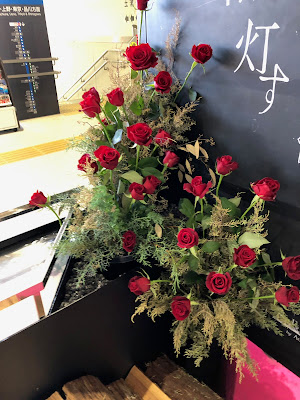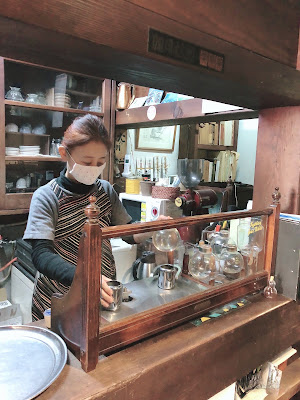目次 / Contents
1) 石岡駅 / Ishioka Station
2) 2つのクリスマスツリー / Two Christmas Trees
3) 香丸資料館 / Kōmaru Archive
A. ドアを開けて / Open the Door
B. 土蔵 / Dozō
C. カフェ / Cafe
D. 2階・ギャラリー / Gallery on First Floor
E. おもしろい場所/ Interesting Place
1) 石岡駅 / Ishioka Station
今年の8月のお盆、9月のお彼岸には、英国にいたので、お墓参りができませんでした。
そのことを気にしていたので、なんとか、今年中に行きたいと思っていて、本日、実現できました。
通常姉Yと行きますが、彼女の都合がつかなかったので、Rと行きました。
前回、石岡駅に来た時と同じ場所にクリスマスディスプレイがありました。
前回は、バラ園の広告を目的としたディスプレイでした。
土台は同じで、バラ園がクライアント?さんであるのも同じだと思われます。
Ishioka Station
My husband R and I went to Ishioka City, Ibaraki Prefecture to visit our family graves.
This year, we were in the UK during the Obon in August and Higan in September, so I was unable to visit the graves.
I was worried about this, so I wanted to go somehow this year, and today I was able to make it happen.
I usually go with my sister Y, but she couldn't make it, so I went with R.
According to Wiki about Obon,
"Obon (お盆) or just Bon (盆) is a fusion of the ancient Japanese belief in ancestral spirits and a Japanese Buddhist custom to honor the spirits of one's ancestors. "
According to Wiki about Higan
"Higan (彼岸, lit. "distant shore") is a Buddhist holiday exclusively celebrated by Japanese sects for seven days; three days before and after both the Spring equinox (shunbun) and Autumnal equinox (shūbun).
It is observed by nearly every Buddhist school in Japan."
There was a Christmas display in the same place as the last time we came to Ishioka Station.
Last time, it was a display advertising the rose garden.
The base is the same, so I think the rose garden is a client?
企画会議の模様が浮かんできそうな、または、企画者の思考の流れがわかるような展示です。
どのお仕事も大変だな〜と思います。
The display gives me a glimpse into the planning meetings that took place, or perhaps the train of thought of the planners.
I think every job is difficult.
 |
| ここが好き! デイル・チフーリ (1941 ~) の作品がちらっと頭をよぎりました。 I like here! At a glance, the work of Dale Chihuly (1941~) came to mind. |
2) 2つのクリスマスツリー
Two Christmas Trees
 |
2つのクリスマス・ツリー 殺風景な場所を明るい雰囲気にしていると思います。 Two Christmas Trees I think they brighten up an otherwise dreary place. |
駅ビルの一角 (通路) に2つのクリスマスツリーのディプレイがありました。
半分野外ということで、屋内では必要のない考慮がいるでしょう。
ここは通路でもあるので人の邪魔にならないようにという配慮もしなければならないでしょう。
設置に必要な見た目には好ましくないハードなものを隠すこともしなければなりませんよね。
努力がうかがえるツリーです。
殺風景な場所を明るくしてくださり、ありがとうございます。
There were two Christmas tree displays in a corner (corridor) of the station building.
Because they're semi-outdoors, some considerations are needed that wouldn't be necessary indoors.
This is also a corridor, so care must be taken not to get in the way of others.
You also have to hide any unsightly hardware needed for the installation.
These trees show the effort that went into them.
Thank you for brightening up an otherwise dreary place.
お墓参りを通常通り、しました。
We visited the family graves as usual.
3) 香丸資料館 / Kōmaru Archive
 |
| 香丸資料館のマッチ箱 Matchbox of Kōmaru Archive |
A. ドアをあけて / Open the Door
以前から、ここはなにかしら?と気になっていた場所がありました。
カフェの看板はかかっていますが、営業しているえようにみえず、
訳がわかりませんでした。
ですが、Rは、カフェにたいして強い好奇心があるので、今日は、
ドアを開けてみました。
撮影の許可を得ています。
 |
| 入り口 / Entrance |
Open the Door
Here was a place I had been wondering about for a while.
There was a cafe sign, but it didn't look like it was open, and the name of the place was "Kōmaru Archive" (Kōmaru Shiryokan), which made me even more confused.
However, R has a strong curiosity about cafes, so today we opened the door.
Permission to photograph has been obtained.
 |
| 玄関周り Around Entrance  このあたりでは、博物館かしら?と思っていました。 When I was here I was wondering if this was a museum.  アンティークでしょうか? Is it an antique? |
B. 土蔵 / Dozō
 |
| 不思議な雰囲気 最近、古民家を利用したカフェやレストランなどがありますが、 そういった店とは違う雰囲気があります。 Mysterious Atmosphere Recently, there have been cafes and restaurants that use old houses, but this place has a different atmosphere to them. |
この建物は、100年前に建てられた土蔵 (ドゾウ) の米倉でした。
1979年に、川村 康曠 (カワムラ タイコウ / 1939 ~ ) 氏が、ここを
アートの発信地として、1階がカフェ、2階がギャラリーに作りました。
ギャラリーは、ほぼ無料で、展覧会やイベント会場に使用できるそうです。
(詳細は毎日新聞記事)
現在、カフェは川村さんの娘さんであるMさん (?~) が経営しています。
Mさんから、土蔵保存の話や、川村さんのその後のお話などを聞きました。
下記のことは、帰宅後に知りました。
長興寺は、石像の五百羅漢 (ゴヒャクラカン) がある寺として有名らしいですが、私は知りませんでした。
羅漢像は、川村氏が住職になってから、境内で、'羅漢を彫る会' によって製作され、 境内に安置されています。
長興寺の羅漢像は、名のある彫刻師やアーティストが製作した像でなく、'羅漢を彫る会' に参加された一般の方々の製作した像であることが特色だと思います。
香丸資料館のあり方と長興寺の羅漢像のあり方に、共通するものを感じます。
同じ方の思想によるのですから、当然といえば、当然ですね。
高尚なものを収集するのでなく、アートにしても、宗教にしても、入り口を低くし、それらに触れることを広める姿勢に重きをおいて実行しているのだと、私は理解しています。
Dozō
This building was a Dozō which is a storehouse with thick earthen (mortar) walls and was built 100 years ago for storing rice.
In 1979, Taikō Kawamura (1939 ~ ) made this place as a centre for art, with a cafe on the ground floor and a gallery on the first floor.
The gallery can be used for exhibitions and events for almost no charge.
At the time, Kawamura ran a transportation company, but he is now a monk, and has been the head priest of Chokō-ji Temple (Sōtō Zen) in Kasumigaura City since 1986. (For details, see the Mainichi Shimbun article in only Japanese, sorry)
The cafe is currently run by Kawamura's daughter, M San (? ~).
M San talked me (us) about the preservation of the Dozō.
I found out the following after I got home.
Apparently Chokō-ji Temple is famous for its 500 stone statues (Gohyakurakan) of arhat, but I didn't know that.
The arhat statues were made in the temple grounds by the 'Arhat Carving Society' and placed there after Kawamura became the chief priest.
I think what makes the Temple's arhat statues unique is that they were not made by famous sculptors or artists, but by ordinary people who participated in the 'Arhat Carving Society'.
I feel that there are similarities between 'how things should be' of the Kōmaru Archive and the arhat statues at The Temple.
This is only natural, since it is based on the same ideology, isn't it?
My understanding is that they do not collect lofty things, but rather place emphasis on lowering the entry level to art and religion, and spreading awareness of these things.
.jpeg) |
| 新聞記事 : 1979年6月5日 Newspaper Article: 5th of June, 1979 |
.jpeg) |
| 川村 康曠氏について '1999年毎日新聞・記名記事' 岩本直紀 (日付はわかりません) About Taikō Kawamura '1999 Mainichi Shimbun, Signed Article' by Naoki Iwamoto (I don't know the date) |
 |
| 銅製の大根おろし? どんぐりが枝に止まる鳩のようにみえ、それぞれの動きが違います。 Copper Daikon (Radish) Grater? The acorns look like doves perched on a branch, each with a different movement. |
C. カフェ / Cafe
 |
| 珍しいやかん 和洋折衷感があるやかんです。 職人さんが作ったものでしょうか? Rare Kettle A kettle with a Japanese-Western feel. Was it made by a craftsman? |
 |
| あんバタートースト(上)とココア(下) Rは満足そうに食べていました。 Red Bean Jam Toast (top) and Cocoa (bottom) |

 |
| ユーモラスなおじさんのカップ (正面) 私は、コーヒーを注文しました。 ビアレッティ カップ&ソーサー でだしてくださいました。 このとき、私は、'ビアレッティ'というブランドを知りませんでした。 ユーモラスなキャラクターとアイディアがあるデザインに惹かれました。 私は、エスプレッソを注文しました。 Humorous Uncle's Cup (Front) I ordered a coffee. It was served in a Bialetti cup and saucer. At the time, I didn't know the brand 'Bialetti'. I was attracted to the design, which had humorous characters and ideas. 反対側 一般的に、このキャラクターは、'髭おじさん' と呼ばれていると知りました。 'イタリア語では、口ひげを生やした小男という意味の l’omino con i baffi と呼ばれています。'(Wiki 英語版より) '髭おじさん' は、イラストレーターの パオロ「ポール」カンパーニ / Paolo "Paul" Campani (1923 - 1991) による、 アルフォンソの息子レナート・ビアレッティ(1923 - 2016) の似顔絵です。 Back I found out that this character is commonly called 'Mustache Man' in Japan. In Italian he is called l’omino con I baffi – "the mustachioed little man". The character is a caricature of Alfonso's son, Renato Bialetti (1923 - 2016), by Paolo "Paul" Campani (1923 - 1991). |
 |
| ビアレッティ製モカエキスプレス イタリア人のアルフォンソ・ビアレッティ(1888 - 1970) は、 イタリアのキッチン用品会社であるビアレッティ・インダストリーズ の創設者です。 彼は、モカ エキスプレスを販売し、会社を発展させました。 公式サイト★ Italian, Alfonso Bialetti (1888 - 1970) was the founder of Bialetti Industries, an Italian kitchenware company. He marketed the Moka Express and developed the company. Official Website : ★ |
D. 2階・ギャラリー / Gallery on First Floor
 |
| 舞台! 正面の展示の棚 (?) は、舞台にもなるような広さがありました。 大型の作品や、着物なども展示できそうです。 Stage! The display shelf (?) at the front is so large that they can double as a stage. |
and even kimonos.
 |
| 立派な梁 梁から想像できるように、2階には広い空間があります。 Magnificent Beam As you can imagine from the beams, there is a wide space on the second floor. |
 |
| 反対側の壁 (左側) Opposite Wall (Left Side) |
 |
| 反対側の壁 (中) Opposite Wall (Centre) |
 |
| 反対側の壁 (右側) Opposite Wall (Right Side) |
彼も見にゆき、満足していました。
I told R that the first floor is an interesting space
and encouraged him to go and see it.
He also went and was pleased with it.
E. おもしろい場所 / Interesting Place
香丸資料館は、ここだけの '何か' があり、深みを感じさせてくれて、おもしろい場所でした。
真里さんが父親の康曠さんに仏事があるときは、送迎をしていらっしゃるので、不定期に閉まることがあるので、いつも利用できるとは限らないそうです。
機会が得られれば、また訪れたい場所だと思います。
 |
| 梵字が入った絵 (版画?) 梵字 (ボンジ) を思わせる形が入った絵(版画?)です。 何を意味しているのでしょうか? Picture (print?) Containing Sanskrit Characters It's a picture (print?) with shapes reminiscent of Siddhaṃ script characters. What does it mean? |
Interesting Place
The Kōmaru Archive was an interesting place with a unique 'something' that gave it a sense of depth.
Mari drives her father, Taiko, to and from Buddhist services, so the Archive is sometimes closed and is not always open.
It's a place I'd like to visit again if I get the chance.















.jpeg)


.jpeg)

0 件のコメント:
コメントを投稿